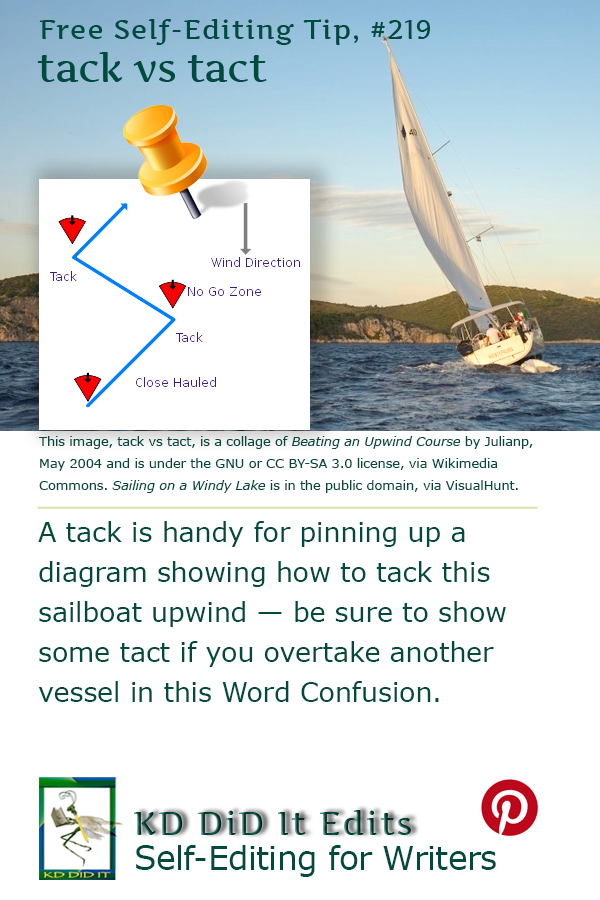Revised as of
3 Jan 2023
Even though part of the definition for tack is “a method of dealing with a situation or problem”, and would seem to be the same as tact‘s polite way of dealing with a situation or problem, tack is a direction in which to choose to be tactful in this pair of heterographs.
Tack has a great many meanings — most of them being about direction — but others involve fastening, physical items — and verbs!
Tact itself is about manners, being polite and considerate.
Word Confusions . . .
. . . started as my way of dealing with a professional frustration with properly spelled words that were out of context in manuscripts I was editing as well as books I was reviewing. It evolved into a sharing of information with y’all. I’m hoping you’ll share with us words that have been a bête noire for you from either end.
If you found this post on “Tack versus Tact” interesting, consider subscribing to KD Did It, if you’d like to track this post for future updates.
| Tack | Tact |
|---|---|

Hunt in Annadel by Robin Mathias is under the CC BY 2.0 license, via Wikimedia Commons. — A saddle is part of the tack used in riding a horse. |

Politeness Simulation courtesy of Trialsanderrors from the United States Library of Congress’s Prints and Photographs division and is in the public domain, via Wikimedia Commons. — Part of tact is being polite. |
| Part of Grammar: | |
| Noun 1, 2; Mass Noun 3; Verb 1, intransitive & transitive Plural for the noun: tacks Third person present verb: tacks |
Noun
Plural: tact |
| Noun: Small, sharp, broad-headed nail 1
Long stitch used to fasten fabrics together temporarily, prior to permanent sewing Method of dealing with a situation or problem
[Sailing] An act of changing course by turning a vessel’s head into and through the wind, so as to bring the wind on the opposite side
[Sailing] A rope for securing the weather clew of a course
Quality of being sticky Equipment used in horseback riding, including the saddle and bridle 2 Mass Noun: Verb, intransitive:
Verb, transitive:
[Sailing] Change course by turning a boat’s head into and through the wind
To equip a horse with tack |
Adroitness and sensitivity in dealing with others or with difficult issues |
| Examples: | |
| Noun: He sat on a tack. As she could not stop him from going, she tried another tack and insisted on going with him. The brig bowled past on the opposite tack. Cooking the sugar to caramel gives tack to the texture. Put that tack up when you’re back from your ride. Mass Noun: That profusion of jewels she’s wearing are such tack. The shop has a profusion of tack. Verb, intransitive: He ordered us to tack at once. Can you tack my horse up quickly? Verb, transitive: She tacked the side seams together. He had long-term savings plans with some life insurance tacked on. You should tack that rug down. |
The inspector broke the news to me with tact and consideration.
That guy has no tact, breaking up with her like that! There are a number of rules in boating that require tact on the part of each captain. |
| Derivatives: | |
| Adjective: tackie, tackless, tacky, tackier, tackiest, ticky-tack, ticky-tacky Adverb: tackily Noun: tacker, tackiness, tacking |
Adjective: tactful, tactless Adverb: tactfully, tactlessly Noun: tactfulness, tactlessness |
| History of the Word: | |
|
Mid-17th century and denoting the sense of touch. Via the French from the Latin tactus, meaning touch, a sense of touch, from tangere, meaning to touch. |
C’mon, get it out of your system, bitch, whine, moan . . . which words are your pet peeves? Also, please note that I try to be as accurate as I can, but mistakes happen or I miss something. Email me if you find errors, so I can fix them . . . and we’ll all benefit!
Satisfy your curiosity about other Word Confusions on its homepage or more generally explore the index of self-editing posts. You may also want to explore Book Layout & Formatting Ideas, Formatting Tips, Grammar Explanations, Linguistics, Publishing Tips, the Properly Punctuated, Writing Ideas and Resources, and Working Your Website.
Resources for Tack versus Tact
Apple Dictionary.com
Pinterest Photo Credits
Beating an Upwind Course by Julianp, May 2004, SVG created by DnetSvg, 2007-09-12, using Inkscape 0.45, and is under the GNU or CC BY-SA 3.0 license, via Wikimedia Commons. Sailing on a Windy Lake, <https://visualhunt.com/photo/94431/>, is in the public domain, via VisualHunt.


